| Construction Rating: | starstarstarstarstar |
| Flight Rating: | starstarstarstarstar |
| Overall Rating: | starstarstarstarstar |
| Manufacturer: | Binder Design  |
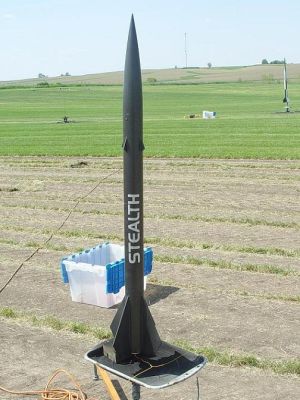
Brief:
The Binder Design Stealth Jr is a single stage, 29mm mid-powered rocket kit
with parachute recovery. The kit features four 1/8" aircraft plywood main
fins, four small 1/8" aircraft plywood canard fins, a generous payload
bay, 12 feet of 3/16" tubular nylon shock cord, and a 24" Binder
Design premium chute. The kit includes pre-slotted airframes for an easier
build and comes with a fin alignment guide.
Construction:
The kit comes extremely well packaged and includes all of the components
necessary to complete the rocket for flight. The packaging is very well laid
out with all of the smaller parts in sub-packages within the main bag. The kit
included the following parts:
- 1 Binder Design 5:1 plastic ogive nose cone
- 4 plastic rivets for securing the nose cone to the payload bay
- 1 payload tube, 12" long x 2.6" OD heavy kraft paper tube, pre-slotted for the forward fin attachment
- 1 airframe tube, 22" long x 2.6" OD heavy kraft paper tube, pre-slotted for through-the-wall attachment of the main fins, and pre-marked for launch lug attachment
- 1 5" long heavy paper (kraft) tube coupler
- 1 29mm motor mount tube, heavy kraft paper, 11" long
- 1 thick paper 1/4" launch lug, 4" long
- 4 pre-cut and sanded forward fins, 1/8" aircraft plywood
- 4 pre-cut and sanded main fins, 1/8" aircraft plywood
- 2 centering rings for the motor mount to the 2.6" airframe, made from 1/4" lite ply
- 1 bulkhead plate, pre-drilled for the eyebolt, 1/4" lite ply, for attachment inside the tube coupler
- 2 #6 eyebolts for shock cord attachment, complete with 4 washers and 4 nuts
- 12' of low-stretch tubular nylon for the shock cord
- 24" premium heavy-duty rip stop nylon parachute
- 10 pages of very well illustrated instructions
- A fin alignment template
- 1 vinyl "STEALTH" decal. My decal was a metallic silver color.
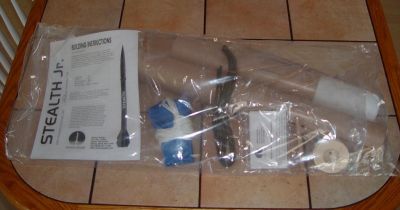
This rocket was my second Binder Design kit to cross my build table and like the first, it was a pleasure to build.
First, the instructions are outstanding! Lots of illustrations and information to walk you through a straightforward build. I kind of jumped around a bit so the actual sequencing of my build is a bit different from the instructions but that is not because the provided build sequence is illogical or anything. I just went about building how I wanted to.
The first step is to drill a hole in one of the motor mount centering rings to attach one of the two eye-bolts for shock cord attachment. The eyebolt is then secured to the centering ring through the hole with a washer and nut on both sides for a snug, secure fit. Then the motor mount is assembled by gluing only the forward centering ring (the one with the eyebolt) at this time. I opted to sand the glassine layer off of the motor mount tube first for better glue adhesion for both the ring and the fins which are attached during a later step. Secondly, because the components involved are kraft paper and plywood, I opted to use Elmer's ProBond wood glue in the construction process. Although the instructions call for 15 or 30 minute epoxy, I elected for this building technique after much discussion on The Rocketry Forum with other builders as well as it was my preference. The aft centering ring is not glued to the motor tube at this time so that it can be removed after the initial tack of the fins for internal fillets. This is well spelled out in the instructions.
The next step is to tie the shock cord to the eyebolt. A nice diagram is provided to describe perfectly the suggested knot to be used (a three-wrap "blood knot"). The instructions called to slather epoxy over the knot to prevent it from loosening later. I found this to be a good suggestion.
After the glue on the forward ring and the epoxy on the knot has set, the next thing to do is pull the shock cord down through the motor tube so that it isn't in the way, apply adhesive to the inside of the airframe at the forward edge of the main fin slots, and slide the motor mount in to glue the forward ring in place. Again, the aft ring is only dry fit on the motor mount tube and should only be dry fit within the airframe to make sure the tube is centered properly as the glue sets. The instructions suggest a nifty "tape-tab" method for removing the snug-fitting aft ring later. Furthermore, the instructions point out you must take care to not get glue inside the airframe in the vicinity of the aft ring so that it can be removed later.
Next, the main fins are applied. I dry fit the fins first to make sure that the slots were cut well and they were a great fit. They were just a shade longer (1/16" of an inch or so) than the fin tabs, so I elected to make them snug against the rear of the fin slots for uniformity. Before applying the fins, I sanded the glassine layer off the airframes exterior about 1/8" around each fin slot for better glue adhesion. Glue is applied to the fin root and they are slid through the slot for attachment to the motor mount tube. Again, care is taken to not get glue on the aft ring area at this time. I simply did not put glue on the 1/2" or so of the fin tab at the rear to prevent a "squish out" that could become a problem there. The provided fin-alignment template made getting them nice and perpendicular a snap!
While the main fins are drying, the canard fins can be attached to the pre-slotted payload. The builder is instructed to insert the tabs on the canards 1/8" through the slots and then apply good fillets inside and out. I was apprehensive with this at first, since there was no interior tube for these fins to attach to. In the end however, these fins are relatively small so this was a non-issue. I applied a thick bead of glue to each side of the fin tab on these forward fins before sliding them in so that there would be something for them to "grab" with and not fall all the way through the slot. If any of this glue beaded up on the outside of the airframe during insertion, I just leveled it out with my finger and chalked it up as part of the filleting process, which worked great! I used a small (1/16") wooden dowel to get the glue in there for the internal fillets. A dowel that small was not necessary, it's just what I had on hand at the time.
Back to the main fins. After they have dried to the motor mount tube, the aft ring is removed and six fillets are applied to each fin. Two on each side at the motor mount tube, two on each side at the inside of the airframe, and two on each side on the outside of the airframe. With four fins, that's 24 fillets. Again, I used wood glue for this and just slathered it in there with my little wooden dowel. It took some patience, but I got it done without much trouble. I did discover that I could fully apply half of the fillets on the first pass, let them set a bit with the rocket held horizontally, then roll the rocket over 180 degrees and apply the other half.
While the fillets were drying, the bulkhead/payload coupler is built and attached. First, the remaining provided eyebolt is secured to the pre-drilled bulkhead plate in the same fashion as the other eyebolt was to the forward centering ring. Two washers and two nuts make for a nice fit. Then the bulkhead plate is glued into the inside of the tube coupler about 1/8" in from one end. Fillets are added to both sides of the bulkplate to complete the assembly. After the glue has dried enough where the fillets won't run, the coupler is glued into the bottom of the payload tube with the bulkhead/eyebolt at the bottom. The coupler is installed about 2.5" into the payload tube, leaving 2.5" for a shoulder into the main airframe when the rocket is assembled. At this point, I set the whole thing aside for the evening to let all the fillets cure completely and picked up the build the next day.
I started construction the following morning knowing that the finish line was near and I'd have a finished bird! I started by removing the dry fit rear centering ring. I opted to drill it and install a pair of T-nuts in it for positive motor retention clips before gluing it in. I then slathered the glue on the inside of the airframe and over the motor tube and slid it in. It wanted to bind and grab because of the wood glue and it took some "coaxing" with a small hammer but I got it in without mishap.
Then the launch lug is installed. As is mentioned in other Binder Design reviews, the launch lug is a very tight fit on a 1/4" launch rod. I tested the lug on my rod before gluing it on and opted to ditch it in favor of a pair of shorter 1/4" lugs that I had in the parts box from Apogee Components. I sanded the glassine off of the pre-marked launch lug line as well as the lugs and put one near the top of the lower airframe and the other near the bottom.
Then the nose cone is slid into place and drilled for the rivets that hold it in, which I feel is a slick method of making sure you don't lose your cone without gluing it in. This enables the builder to remove it and actually utilize that big payload bay! First, the nose cone required about 10 wraps of masking tape to get a secure fit in the payload tube. This is common with Binder Design kits, and although the shoulder is loose within the airframe, the OD of the base of the cone matches the OD of the airframe very well. Once the nose cone is in, four holes are drilled at 3/4" below the top of the payload tube for the plastic rivets. With the payload tube marked for the provided cuts for the canard fins, getting these holes evenly spaced around the tube was a snap. After the four holes are drilled, the plastic rivets are simply pushed through the holes, effectively locking the cone in place until the rivets are removed.
All that's left now is to tie the shock cord to the eyebolt on the payload and attach the chute. The shock cord is tied to the forward eyebolt in the exact manner as it is to the forward centering ring. As for the parachute, the instructions call to use the "pull through the loops" method and attach it directly to the shock cord a few inches below the knot at the bulkplate attachment point. I opted to attach the shroud lines to a heavy sampo swivel/clip instead so I could remove it for storage and possible use in other birds. For flight, I'd just clip the parachute to the eyebolt.
PROs: Great packaging, wonderfully clear instructions, good fitting high quality parts that can be assembled without special building techniques, and no "gotchas" in the build that I can think of
CONs: The launch lug is too tight and needs replaced, and there is no positive motor retention provided (minor detail).
Finishing:
I hardly bother with filling tube spirals, especially with mid powered rockets.
My experience with rockets of this class and higher is that people don't look
at them with magnifying glasses and inspect your fine modeling skills as when
showing off finely crafted "model" rockets. So, no comment on the
spirals from me. I don't find them noticeable, particularly with these tubes
anyway. However, I did use Elmer's Fill 'n' Finish to patch the gaps in the
forward and rear ends of the fin slots where necessary. The instructions
suggest a spot-putty or Bondo type product for this, but being paper and wood,
I thought the wood filler would be fine. I dabbed it in there and sanded off
the excess which came out great!
For the fins, I masked the tube areas off and applied two heavy coats of Folk Art aerosol sanding sealer and sanded with 400 grit between coats. This filled all the grains in the fins to a plastic-like, smooth finish.
The nose cone required minor sanding to remove some mold flashing in addition to standard sanding needed on a plastic cone prior to painting for better adhesion.
For paint, I was happy to work with a rocket with a single color paint scheme for a change. Primer and paint. Simple. I gave it two coats of Krylon gray primer, sanding in between coats. For the main color, the kit art appears to be gloss black with a white decal. Since my provided decal was metallic silver, I opted for Rustoleum Midnight Black Metallic. This stuff looks splendid, dries quickly, and goes on smooth.
After the paint dried overnight, the decal was applied. For me, I laid the decal on the airframe before removing the backing paper to make sure it would look good in the designated spot. At first, I laid it entirely on the lower airframe, just below the seam of the airframe and the payload bay. This just made the decal look to low or off-center somehow to me. So after thinking about it a bit, I slid it forward with the "H" on the payload, the "STEALT" on the lower airframe, and the seam splitting the "T" and "H". This looked a lot better to me. So I took great care to make sure I had the canard fins and main fins lined up, removed the backing paper, sprayed the decal and that application spot with soapy water, laid it down, pressed out the bubbles, let it dry, and presto! Being a stickler for making sure everything lines up for flight, this decal placement actually helps in the field. Just slide the two halves together and twist until the decal is in alignment. Ready to go!
PROs: One color paint scheme and high quality cut-vinyl decal.
CONs: None.
Construction Rating: 5 out of 5
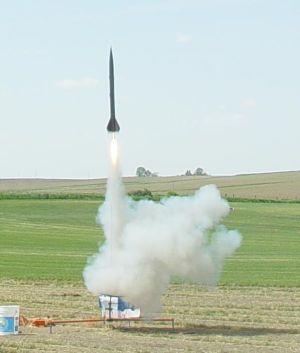
Flight:
My first flight with this rocket was going to be part of my first experience
actually building and using RMS motors, so naturally I was nervous. With the
recommended motors being simply "F and G", that wouldn't settle for
me. I emailed Mike Fisher with Binder Design and he sent me the RockSim file
for this rocket. I used RockSim to run the "non-Level 1" reloads
through the sims to try and come up with some better suggestions. I had the
cases, so what the heck.
My first concern in picking motors wasn't so much the altitudes. I was looking for the slowest projected velocity at deployment based on my simulation inputs. I printed out my simulation data and was off to a Tripoli club launch where Tim Lehr, the "Wildman" from Wildman Rocketry, was the onsite vendor and was a great help. My first choice was a G64-7 reload but that wasn't available. My second choice was a G54W in my 29/100 case with a RDK-3 short delay. That was the ticket for the day.
The Stealth Jr was my 5th flight of the day. The reload was assembled and installed, and I clamped down my home grown motor retention clips. Then, I dropped a couple of handfuls of "dog barf" cellulose wadding in the airframe, looped in that long shock cord, folded and packed the parachute, and put the payload bay in place and headed for the pads.
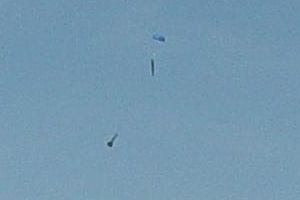 The G54W
was a perfect first flight. Straight as an arrow with a nice quick boost. The
delay change to the 6 second delay was even better. Just as the rocket
flattened out at apogee, the payload separated at ejection and you could see
the big chute unfurl and inflate before that 12' cord uncoiled completely. The
rocket gently swung into recovery position and drifted down for a soft landing
on the sod.
The G54W
was a perfect first flight. Straight as an arrow with a nice quick boost. The
delay change to the 6 second delay was even better. Just as the rocket
flattened out at apogee, the payload separated at ejection and you could see
the big chute unfurl and inflate before that 12' cord uncoiled completely. The
rocket gently swung into recovery position and drifted down for a soft landing
on the sod.
The second flight was a personal launch at a friend's farm. This time, I had gotten a hold of a G64-7 for my 29/40-120 case. The results were the same, only a much snappier boost and quite a bit higher. Again, a great flight with a sweet looking, sweet flying bird.
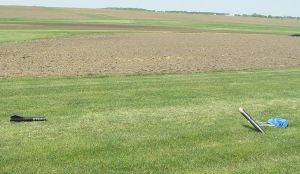 PROs:
What can you say? Stable, arrow straight and looks good on the pad and in the
air.
PROs:
What can you say? Stable, arrow straight and looks good on the pad and in the
air.
CONs: A more definite motor selection matrix would be a plus.
Recovery:
The provided parachute is just beefy. Nice heavy shroud lines, and my flights
provided a nice, soft deployment and scratch free landings.
I might consider a tubular Kevlar® protector for the shock cord for longevity, but I have had no problems with scorching or melting to this point. Dog barf works great for me as a wadding, and after two flights the Stealth Jr is still "good as new."
PROS: My flights recovered perfectly with acceptable drift and no damage.
CONS: Can't think of any!
Flight Rating: 5 out of 5
Summary:
I really like this rocket! Great materials, great packaging, goes together
well, and looks really great when you're through. A super solid build that
feels light, yet extremely sturdy. My next flight is planned with an H165R
reload for a Level 1 certification flight. Based on my experience flying this
rocket and the simulated altitude of about 2100' with that reload, I'm sure
that it will be very doable. I'd recommend this rocket to anyone in the market
for a 29mm powered kit.
Overall Rating: 5 out of 5
 |
 |
Flights
 |
 |
Sponsored Ads
 |
 |












B.C. (April 4, 2010)